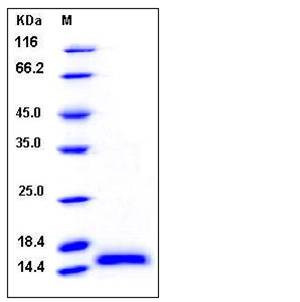Human PHPT1 / PHP14 Protein (His Tag)
CGI-202,HEL-S-132P,HSPC141,PHP14
- 100ug (NPP4168) Please inquiry
| Catalog Number | P12473-H07E |
|---|---|
| Organism Species | Human |
| Host | E. coli |
| Synonyms | CGI-202,HEL-S-132P,HSPC141,PHP14 |
| Molecular Weight | The recombinant human PHPT1 consisting of 135 amino acids and has a calculated molecular mass of 15.2 kDa as estimated in SDS-PAGE under reducing conditions. |
| predicted N | Met |
| SDS-PAGE |  |
| Purity | > 97 % as determined by SDS-PAGE |
| Protein Construction | A DNA sequence encoding the human PHPT1 (Q9NRX4-1) (Ala 2-Tyr 125) was expressed, with a polyhistidine tag at the N-terminus. |
| Bio-activity | |
| Research Area | Immunology |Cytokines & Growth Factors |Growth Factor & Receptor |Ephrin & Eph Receptor |Ephrin |
| Formulation | Lyophilized from sterile PBS, pH 7.4 1. Normally 5 % - 8 % trehalose, mannitol and 0.01% Tween80 are added as protectants before lyophilization. Specific concentrations are included in the hardcopy of COA. |
| Background | PHPT1, also known as 14 kDa phosphohistidine phosphatase, phosphohistidine phosphatase 1, protein janus-A homolog, PHP14, is a cytoplasm protein which belongs to the janus family. PHPT1 / PHP14 is expressed abundantly in heart and skeletal muscle. Phosphatases are a diverse group of enzymes that regulate numerous cellular processes. Much of what is known relates to the tyrosine, threonine, and serine phosphatases, whereas the histidine phosphatases have not been studied as much. Protein histidine phosphorylation exists widely in vertebrates, and it plays important roles in signal transduction and other cellular functions. Protein histidine phosphorylation accounts for about 6% of the total protein phosphorylation in eukaryotic cells. The knowledge about eukaryotic PHPT (protein histidine phosphatase) is still very limited. To date, only one vertebrate PHPT has been discovered, and two crystal structures of human PHPT1 have been solved. PHPT1 / PHP14 can dephosphorylate a variety of proteins (e.g. ATP-citrate lyase and the beta-subunit of G proteins). A putative active site has been identified by its electrostatic character, ion binding, and conserved protein residues. |
| Reference |
